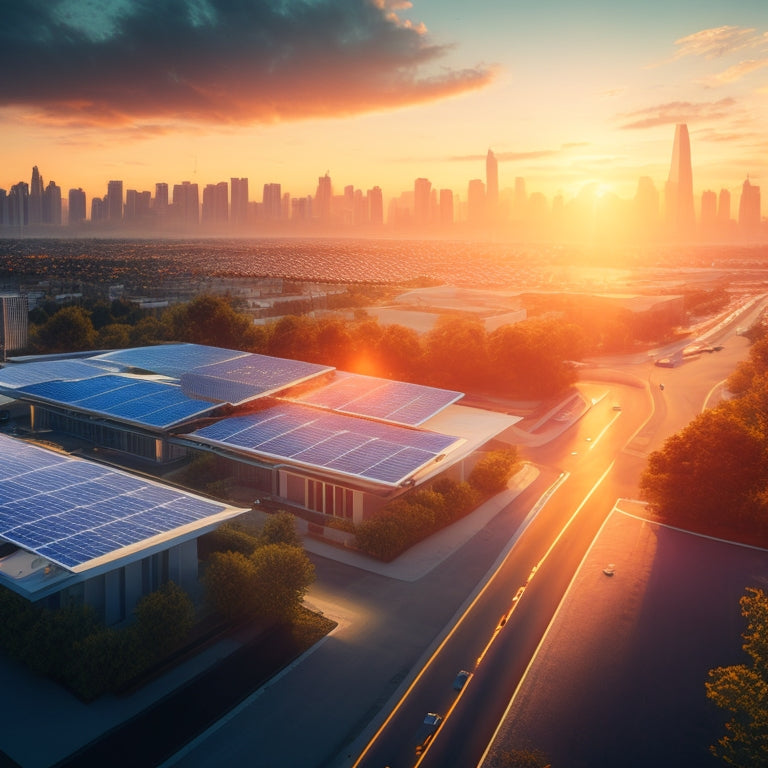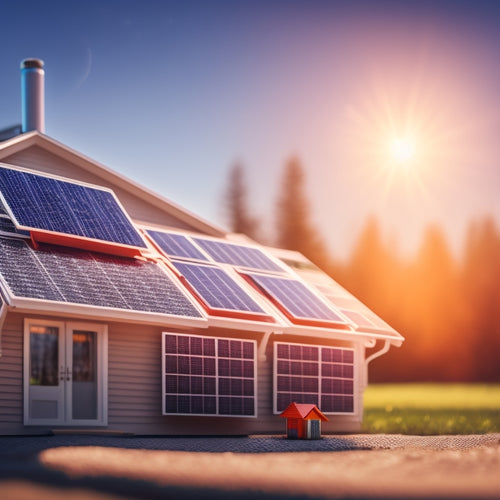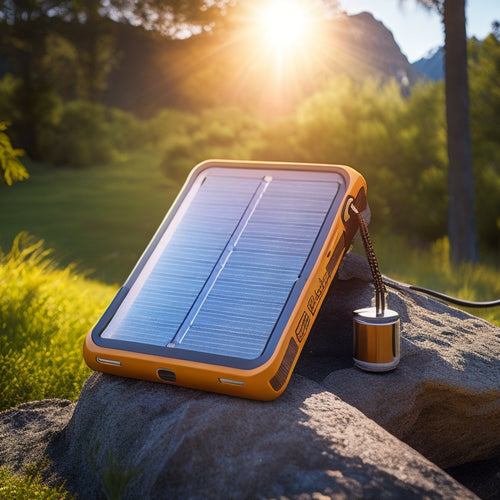
Solar Power Grid
Share
You're incorporating solar power into your energy infrastructure to break free from fossil fuels and utilize the clean, renewable energy of the sun. As you evaluate energy requirements, you'll determine the ideal solar array size, ensuring high-efficiency panels and reliable inverters maximize energy production. Grid integration allows excess energy to be fed back, offsetting consumption. With advanced technology, you'll achieve energy autonomy, reducing your carbon footprint and energy bills. Now, you're on the path to a sustainable future - investigate how to enhance your solar power grid further, uncovering the complexities of system design, energy storage, and maximum power point tracking to reach your renewable energy goals.
The Essentials
- A solar power grid integrates solar panels, inverters, and energy storage to generate clean energy, reducing reliance on fossil fuels and mitigating climate change.
- Optimizing energy output capacity requires evaluating solar panel array size, configuration, and quality, as well as balancing energy needs with space and budget.
- Maximum power point tracking (MPPT) algorithms and efficient power conversion ensure maximum energy harvesting, while real-time monitoring adjusts performance for optimal energy production.
- Community solar programs and incentives increase accessibility and affordability of solar power, driving adoption and contributing to a zero-carbon footprint future.
- Advanced solar technology and energy storage solutions enable efficient and cost-effective clean power generation, paving the way for a sustainable energy future.
Renewable Energy Independence Now
You're now on the path to achieving energy self-sufficiency, where you generate and consume your own clean power.
With renewable energy sources, you can break free from reliance on non-renewable resources and reduce your carbon footprint.
By investing in an off-grid solar kit, you can solve three major problems that come with relying on the grid or generators: high energy costs, noisy and polluting fuel-based systems, and limited access to power in remote areas.
Energy Self Sufficiency Now
How can we break free from the shackles of fossil fuels and achieve energy self-sufficiency now? By utilizing the power of solar energy, you can take control of your energy needs and adopt a sustainable lifestyle.
With an All in One Solar Power System, you can streamline the shift to renewable energy and guarantee a steady power supply even when the grid is down. Energy autonomy is within your grasp, and it starts with a well-designed solar power grid.
You can begin by evaluating your energy requirements and determining the size of the solar array needed to meet your needs. Next, you'll need to select the right solar panels and inverters for your system.
It's crucial to choose high-efficiency panels and reliable inverters to maximize energy production.
With a well-designed solar power grid, you can enjoy energy autonomy and greatly reduce your reliance on fossil fuels. This means you'll be producing clean energy, reducing your carbon footprint, and saving money on your energy bills.
Clean Power Generation
By utilizing the power of solar energy, you're taking an important step towards renewable energy independence now, effectively severing your reliance on fossil fuels and mitigating their devastating environmental impact.
Solar technology has advanced greatly, enabling efficient and cost-effective clean power generation. Grid integration is now a seamless process, allowing you to feed excess energy back into the grid and offset your consumption.
With the ability to alleviate reliance on the traditional energy grid, you can shield yourself against unforeseen power outages and reduce your energy costs over time. Additionally, solar power grids also promote a healthier environment by generating clean and renewable energy, combating climate change and its adverse effects.
Photovoltaic advancements have led to increased energy yields, reducing the environmental impact of traditional power generation. Energy storage solutions have also improved, ensuring a stable and reliable supply of clean energy.
Smart grids enable real-time monitoring and management of energy distribution, optimizing efficiency and reducing waste. Community solar programs and policy incentives encourage the adoption of sustainable solutions, making clean power generation more accessible and affordable.
With cost reduction being a key driver, you can now enjoy the benefits of clean power generation without breaking the bank.
Zero Carbon Footprint
You're now exploring the heart of a solar power grid: achieving a zero carbon footprint. This means relying entirely on renewable energy sources, such as solar power, to generate electricity.
By installing photovoltaic systems, you can capture the power of the sun to fuel your home, reducing your reliance on fossil fuels and lowering your utility bills.
In doing so, you'll be opening the door for an emissions-free future, where energy production no longer harms the environment.
Renewable Energy Sources
As the world shifts towards a more sustainable future, what role do renewable energy sources play in mitigating climate change and reducing our carbon footprint?
Renewable energy sources, like solar technology, are essential in the shift to a zero-carbon economy. Energy innovation and sustainable practices are driving the adoption of green infrastructure, minimizing environmental impact.
Governments are implementing energy policies and solar incentives to encourage the integration of renewable energy into the grid. Community solar programs and energy storage solutions are making solar power more accessible and efficient.
The photovoltaic systems' increasing solar efficiency is driving down costs, making renewable investments more attractive.
As you consider your role in the energy shift, you'll find that solar adoption is becoming a key component of our collective effort to reduce greenhouse gas emissions.
Emissions-Free Future
Rapidly, the world is moving towards an emissions-free future, where a zero-carbon footprint is the ultimate goal. As you traverse the shift to a sustainable energy environment, it's crucial to understand the key drivers of this change.
| Category | Current Status | Future Outlook |
|---|---|---|
| Energy Policies | Incentivizing green technology adoption | Implementing stricter regulations to curb emissions |
| Solar Innovations | Advancements in panel efficiency and storage | Next-gen solar cells with higher energy yields |
| Community Engagement | Raising awareness on climate change impacts | Active participation in shaping energy policies |
| Technological Advancements | Improving energy storage and grid integration | Developing smart grids for efficient energy distribution |
You'll notice that sustainable practices, environmental impact, and future investments are interconnected. By adopting green technology, you'll reduce your carbon footprint, and with policy incentives, the shift becomes more feasible. As you invest in solar innovations, you'll be part of the solution to climate change. The future of energy is in your hands, and with community engagement, you can shape the policies that will drive this emissions-free future.
Maximum Power Point Tracking
You need to optimize energy harvesting by identifying the maximum power point of your solar panels, as it varies depending on factors like temperature and irradiance.
To achieve this, you'll employ maximum power point tracking (MPPT) algorithms that continually monitor and adjust the operating point of your panels, considering the performance of off-grid systems and the capacity of your solar battery backup systems.
This is vital, especially during periods of reduced utility bills when you're relying heavily on renewable energy storage solutions.
Optimizing Energy Harvesting
Several factors affect the efficiency of a solar power grid, but one essential aspect is optimizing energy harvesting through Maximum Power Point Tracking (MPPT). You can think of MPPT as a "maximizer" that guarantees your solar panels operate at their highest potential, even when environmental conditions change.
By tracking the maximum power point, you can increase energy storage and reduce the strain on your grid integration. This, in turn, enhances the overall performance of your solar technology.
To get the most out of your system, you'll want to evaluate battery efficiency, smart grids, and load management. By optimizing these components, you can scale your system up or down as needed, making it more cost-effective and efficient.
What's more, you can take advantage of solar incentives and monitor your performance in real-time, making adjustments on the fly. By optimizing energy harvesting, you'll see a significant reduction in costs and a significant increase in freedom from the grid.
With MPPT, you can rest easy that your solar power grid is running at its best, giving you the independence you desire.
Efficient Power Conversion
Two key stages comprise the efficient power conversion process in a solar power grid: DC-DC conversion and DC-AC inversion. You'll find that these stages are essential to maximizing solar efficiency and ensuring a stable output.
DC-DC conversion involves elevating or stepping down the voltage to match the requirements of the inverter. This stage is vital for achieving maximum power point tracking (MPPT), which optimizes the energy extracted from the solar panels. You can expect DC-DC conversion to enhance the overall efficiency of the power conversion process.
The following table highlights the key characteristics of DC-DC conversion and DC-AC inversion:
| Stage | Function | Efficiency |
|---|---|---|
| DC-DC Conversion | Voltage adjustment for MPPT | 95-98% |
| DC-AC Inversion | Conversion to AC for grid connection | 98-99% |
| Total Efficiency | Combined efficiency of both stages | 93-97% |
System Size Matters Most
You'll find that the system size of your solar power grid directly impacts its energy output capacity, with larger systems generating more power.
As you investigate renewable energy solutions, it's crucial to contemplate the role of photovoltaic cells in utilizing energy efficiency.
However, as system size increases, so does design complexity, requiring more sophisticated components and infrastructure.
When determining the ideal system size, you'll need to balance energy output capacity with the added complexity and costs that come with larger systems.
Energy Output Capacity
With solar power grid systems, energy output capacity is a vital factor, as it directly impacts the amount of electricity generated. You need to take into account the maximum power output your system can produce, measured in watts (W) or kilowatts (kW), to guarantee it meets your energy demands.
Capacity factors, which represent the ratio of actual energy output to the system's maximum potential output, also play an essential role. A higher capacity factor indicates a more efficient system.
When determining your energy output capacity, you'll need to assess your solar panel array's size, configuration, and quality. Larger systems with more efficient panels can generate more electricity, but they also require more space and resources.
You'll need to balance your energy needs with the available space and budget. A well-designed system with a suitable energy output capacity can provide you with the freedom to generate your own clean energy and reduce your reliance on the grid.
System Design Complexity
The intricacy of a solar power grid system's design is largely driven by its size, as larger systems require more intricate configurations to guarantee ideal energy production.
You'll find that system scalability is a significant challenge, as you need to balance energy output with grid compatibility and maintenance factors.
To overcome these design challenges, you'll need to develop effective integration strategies that capitalize on technology advancements. This might involve investing in advanced inverters, smart panels, and sophisticated performance monitoring systems.
When conducting a cost analysis, you'll need to contemplate not only the upfront costs but also the long-term regulatory impacts and user engagement strategies.
As you maneuver through the intricacies of system design, remember that each component affects the overall performance and efficiency of the grid.
Higher Energy Harvest Rate
You're likely familiar with the concept of peak sun hours, which represents the amount of energy your solar panel system can utilize from the sun.
Peak sun hours are typically measured in kilowatt-hours per square meter (kWh/m²) and vary depending on your location and time of year.
Understanding peak sun hours is essential in optimizing your solar power grid's energy harvest rate.
Peak Sun Hours
Utilizing solar energy efficiently relies on understanding peak sun hours, a vital factor in determining a solar panel's energy harvest rate. You need to know how many peak sun hours your location receives to optimize your solar panel's performance.
Peak sun hours measure the amount of solar radiation available at your location, which affects your panel's energy output. Climatic factors like cloud cover, fog, and temperature influence the number of peak sun hours, making geographical impact a significant consideration.
When evaluating your solar panel's performance, you'll want to evaluate metrics like energy storage capacity, panel orientation, and seasonal variations in energy production.
Efficiency ratings also play a significant role, as they determine how well your panel converts sunlight into electricity. Shading issues, whether from trees or buildings, can reduce your panel's energy output, so it's important to assess these factors when planning your installation.
Frequently Asked Questions
Can Solar Power Grids Operate Independently of Traditional Energy Sources?
You can achieve energy independence by designing a grid that operates independently of traditional sources, ensuring grid resilience through advanced weather forecasting, energy storage, and smart grid management, freeing you from reliance on fossil fuels.
How Does Solar Power Grid Efficiency Compare to Fossil Fuels?
You investigate the myth that fossil fuels outperform solar power in efficiency. Surprisingly, you uncover that solar power's 15-20% efficiency rate rivals fossil fuels', which often dip below 40% due to transmission losses, making solar power advantages shine brighter amidst fossil fuel limitations.
Are Solar Power Grids Suitable for Residential Areas Only?
You wonder if decentralized energy systems are limited to residential areas; however, you'll find that grid scalability allows them to thrive in both residential and commercial settings, making them a viable option for all.
Can Solar Power Grids Be Integrated With Existing Infrastructure?
As you ponder upgrading your community's infrastructure, imagine seamlessly merging innovative energy solutions with existing structures. You can integrate solar panel systems with energy storage solutions, unfastening a harmonious blend of old and new, liberating your community from reliance on traditional power sources.
How Often Do Solar Power Grid Components Need Maintenance?
You'll find that maintenance frequency depends on component lifespan; typically, you'll need to inspect and replace parts every 5-10 years, ensuring peak performance and minimizing downtime, while also extending the overall system's lifespan.
Final Thoughts
By utilizing the power of solar energy, you can break free from reliance on fossil fuels and achieve renewable energy independence. Imagine a future where your community is powered entirely by clean energy, like the town of Greensburg, Kansas, which was rebuilt with 100% renewable energy after a devastating tornado. With a well-designed solar power grid, you can maximize your energy harvest rate, reduce your carbon footprint to zero, and create a sustainable future for generations to come.
Related Posts
-

A Beginner's Guide to Navigating the Solar Investment Tax Credit
You're eligible to claim a significant Solar Investment Tax Credit (ITC) of 30% of total installation costs, but mane...
-

Fastest Solar Chargers for Emergency Power
When choosing the fastest solar chargers for emergency power, you need to focus on features like rapid charging capab...
-

Choosing the Right Solar Power Charge Controller
Choosing the right solar power charge controller is crucial for maximizing energy efficiency and extending battery li...


